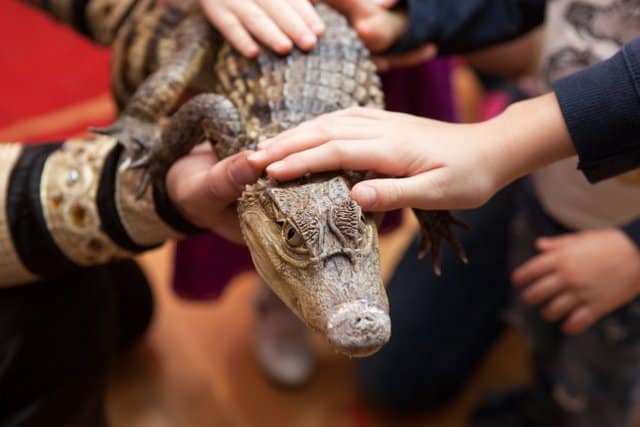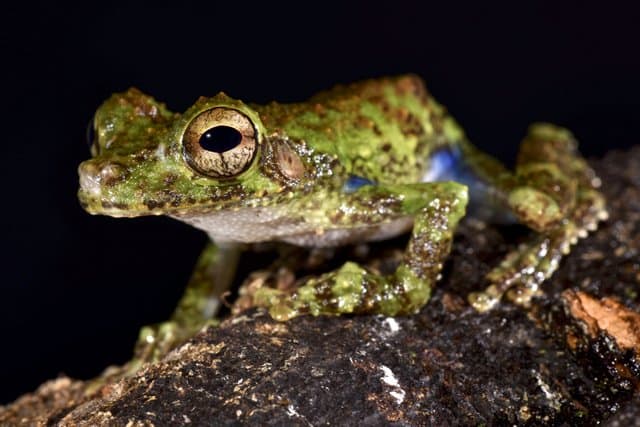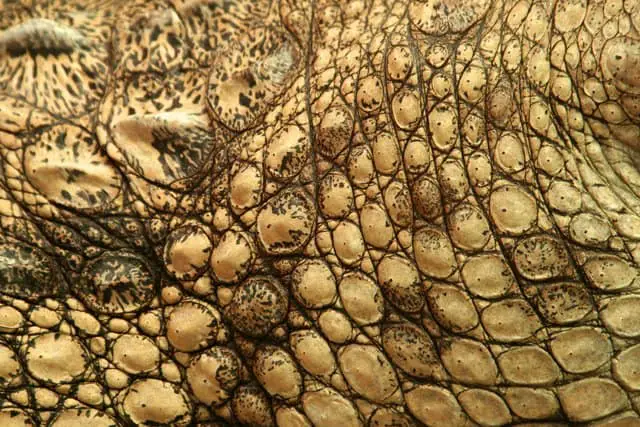Dinosaurs Had Scales And Some Were Covered in Feathers (Including Tyrannosaurus Rex)
What Does Dinosaur Skin Feel Like? Imagine reaching back through the eons, your fingers brushing against the rough, scaly hide of a creature from a bygone era. Dinosaurs, those colossal enigmas of prehistory, have left behind more than just bones; they’ve left whispers of their existence etched in stone. In the grooves of fossilized impressions, we’ve unearthed secrets of their once-tangible armor. The notion tickles our curiosity, beckoning us to explore the tangible past of these extinct titans.

What Does Dinosaur Skin Feel Like?
Dinosaur skin had a bumpy or scaly texture if you touched it, based on dinosaur skin fossil records. Some T. Rex species are found to have had pebble-like scales, giving the touch and feel of bumpy skin. Other dinosaurs grew feathers atop their skin, and the touch would feel feather-soft, but for dinosaurs with early proto-feathers, you would feel bumps underneath the feathers.
Key Takeaways
- Dinosaur skin texture varied significantly, ranging from bumpy and scaly to feather-soft.
- Many dinosaurs had skin similar to modern-day crocodiles and frogs, with non-overlapping scales.
- T. Rex fossils indicate a skin type that was both smooth and scaly.
- Feathers were a feature atop the skin of certain dinosaurs, serving multiple functions.
- Hadrosaurs are notable for having the highest number of preserved skin samples.
- Despite prevalent beliefs, not all tyrannosaurids were feather-covered; some had scaly skin.
Although you might never get to pet a Velociraptor in real life (nor should you really want to), we’ve packed this post full of information so you’ll have a much better idea of what said petting would feel like. From the thickness of dinosaur skin to which modern-day creatures have a similar skin texture, this is one article you’re not going to want to miss!
Different Dinosaur Types Have Different Skin
Dinosaur skin was typically made of scales that didn’t overlap each other, and that also had bumps on it. Scientifically, these scales are known as tubercles and gave the bumpy feeling if you were to touch them. This type of skin is found on modern-day crocodiles and even frogs.
When you look at some images and even recreations of dinosaurs, these creatures’ skin appears rather smooth. Other species undeniably seem to have a rougher, bumpier look and feel. To get a better perspective, let’s take a look at some of the fossil discoveries of different dinosaurs and discover what the fossil skin or fossil skin impressions tell us.
T. Rex Skin
Paleontologists have studied T. Rex’s skin fossils and have tried to determine the skin’s texture, whether with scales or bumpy.
The answer, as it turns out, is both, at least sometimes. This Science Magazine article from 2017 mentions works done by staff at the Houston Museum of Natural Science. The researchers got to study T. Rex fossils, which are pretty hard to come by. Some of the fossils included species like the Gorgosaurus and Albertosaurus.
According to the article, the T. Rex species possessed “smooth, scaly skin.” UK news source The Guardian, in an article from 2015, discusses another study on dinosaur fossils, this time from Toronto’s Royal Ontario Museum and Sweden’s Uppsala University. The team reviewed an assortment of dinosaur fossils, somewhere in the ballpark of 75 different species. The researchers, too, reported that dinosaur skin was scaly.

A BBC article published in 2016 mentions research from the Smithsonian Museum of Natural History, London’s Natural History Museum, and other sources. The article states that dino species like Triceratops had scaly skin, much like an alligator or crocodile would today (more on this a little later!).
These various sources tell us that dinosaurs may have been smooth but predominantly scaly. Some dinosaurs were known to be feathered. Not as many species as you might have think boasted feathers, something that all the above sources emphasized.
————————————————————————————————
You Might Also Be Interested In These T. Rex Articles:
How Would A T-Rex Get Up After Falling?
7 Surprising Facts About Sue The Dinosaur- Most Complete T-Rex Fossil
Would A T-Rex Really Shake The Ground?
————————————————————————————————

Mummified Hadrosaur Skin From North America
Let’s take a look at a different species of dinosaurs, the Hadrosauridae. Paleontologists have been able to study the skin of Hadrosaurs because of some exceptional fossil discoveries. Here are two of the best-preserved examples, both from North America.
The first is a mummified dinosaur known as “Leonardo”, a Brachylophosaurus from the Upper Cretaceous Judith River Formation of Montana. It amazingly had 90% of its body covered by imprints of its skin. The skin details show the non-overlapping tubercles or bumps in different patterns along most of its body giving scientists a stunning example of what kind of dinosaur skin covered the Hadrosaur. (Source)
Table 1 -Dinosaur Skin Feeling of Different Dinosaur Types
| Dinosaur Name | Dinosaur Skin Feeling | Dinosaur Type | Where Fossils Found |
|---|---|---|---|
| Tyrannosaurus rex | Smooth and bumpy | Theropod, Carnivore | USA, Canada - North America |
| Brachylophosaurus | Smooth and bumpy | Hadrosaur | Montana, USA |
| Sinocalliopteryx gigas | Feathery feeling with bumps from protofeathers | Compsognathid theropod | China |
| Borealopelta markmitchelli | Rough and bumpy, scaly feeling | Nodosaur - Ankylosaur | Alberta, Canada |
| Kulindadromeus | Feathery feeling with bumps from protofeathers | Theropod, Basal (primitive) Orinthsauria | Russia |
| Edmontosaurus annectens | Smooth and bumpy | Hadrosaur | Montana, USA |
| Archaeopteryx lithographica | Feathery feeling with bumps from protofeathers | Maniraptoriformes | Germany |
| Dinosaur Name | Dinosaur Skin Feeling | Dinosaur Type | Where Fossils Found |
The second Hadrosauridae is a near-complete mummified Edmontosaurus, Discovered in 1908 in the United States near Lusk, Wyoming. You can clearly see approximately two-thirds of its skin, and the dinosaur was covered in tubercles – small, round-shaped, and a bit larger rectangle-shaped. This skin’s feeling would most likely be smooth yet bumpy and similar to a crocodile, as mentioned above. (Source)
If you are interested in reading more about duck-billed hadrosaur dinosaurs, check out my article – Types of Duck Billed Dinosaurs -Names, Habitats, Nests.
Protofeathers From Primitive Theropod Species
The plant-eating dinosaur Kulindadromeus, whose fossil remains were found in Russia, is unique as it gives a representation of dinosaurs with protofeathers. A basal (primitive) theropod dinosaur from the Jurassic period, the protofeathers it had could have been the origins of both Dinosauria and Ornithischia evolutionary feathers. These protofeathers would feel soft but with bumps because there was a rather large single filament for each protofeather. (Source)
The Thick and Armored Skin of the Nodosaur
Then there is the Borealopelta from the Canadian mines, known as the Suncor Nodosaur. Its skin could be better described as thick, armored scales and the fossil remains of the Borealopelta is famous for being the most well-preserved armored dinosaurs to have been found. The skin or armor plating of the Nodosaur is preserved in such detail that the armored scales and spikes can be seen covering most of the top part of the dinosaur as well as its undersides. Naturally, this dinosaur’s skin or armor’s touch and feel would be bumpy scales and considerably thick. (Source)
I wrote an in-depth article about how dinosaurs protected themselves with armor and other weapons, check it out here: How Did Dinosaurs Protect Themselves? (Armor, Weapons)
The Thickness of Dinosaur Skin – What Fossils Tell Us
Okay, so that solves the dilemma of what dinosaur skin feels like, but what about how thick it is? You imagine that long-living dinosaur species must have had very thick skin. If they didn’t, then any scratches, bites, or other lacerations could have punctured crucial arteries and organs, quickly leading to the dino’s death.
Prepare to be amazed. A 2019 study published in the journal Palaeontology through The Palaeontological Association did a 3D study on dinosaur soft tissue based on fossil records. The dinosaurs featured in the study were non-avian.
What did the researchers find? The fossilized dinosaur skin sample had a skin thickness of 3 millimeters, which is 0.118 inches. For comparison’s sake, human skin is 2 millimeters or 0.07 inches thick.
Yes, that means that dinosaur skin was only about a millimeter thicker than the skin on our bodies, at least according to the results of that study that compared the fossil skin and skin impressions that have been found.
However, you have to keep in mind that dinosaurs had something we humans don’t: scales. Although the scales may not have added much to the thickness of a dinosaur’s skin, scales certainly made skin harder to damage. With this built-in layer of protection, a dinosaur couldn’t easily be lacerated or bitten despite their skin being somewhat thin.
The Palaeontology study says their researchers looked at ornithischians due to the abundance of preserved soft tissue common among this species. Ornithischians included hypsilophodontids, heterodontosaurs, iguanodontids, and hadrosaurs. A Yale article from 2014 says that of the dinosaurs to have had their skin preserved, hadrosaurs are high on the list. Up to 90 percent of the dinosaurs the researchers found in Hell Creek that had skin samples were hadrosaurs.

Skin Comparisons with Modern-Day Reptiles and Birds
Dinosaurs may be long extinct, but they live in on some modern-day creatures that roam the earth. Let’s look at five animals with prehistoric backgrounds and compare how their skin feels based on what we know about dinosaur skin.
Crabs
Whether you like looking at crabs at your local aquarium or even eating them from time to time, these crustaceans have a very interesting history. The first crabs sprang to life in the Jurassic Period, which was 146 to 200 million years ago. During the Cretaceous Period, which marked the end of the dinosaurs, crabs were doing more than well, and they were thriving.
What wiped out the dinosaurs didn’t do the same to crabs. Fossils of one crab species called the Megaxantho Zogue tell us that crabs at the time were far larger than the ones we’re used to seeing today. The Megaxantho was so large that it could snap the shells of smaller animals with ease. It helped it feed and survive. It’s no wonder then that crabs still have a large claw, although it’s not as big as the Megaxantho’s was!
Crabs are covered in shells, and although this might seem like a far cry from dinosaurs, it isn’t necessarily. The Ankylosaurus is one of the best-known shelled dinosaur species. Besides the shell on its back, which featured spikes for defense, the Ankylosaurus was said to have shelled eyelids as well. We can’t really say what purpose that would have served for this species.
Shells are incredibly valuable in animals. The hard layer protects the tender, vulnerable skin underneath. Besides its massive claw, crab species probably survived to this day because of their shells. Dinosaurs also could have used shells to safeguard themselves from biting or scratching predators, as the shell was much harder to puncture than dino skin.
Sharks
The seas were rife with sharks for far longer than you may have thought, somewhere around 450 million years back. At that point, sharks didn’t look much like the fearsome creatures we know them as today. It was around 100 million years that the groundwork for modern sharks was laid.
Surely, you’re familiar with the Megalodon, a prehistoric, extinct shark species related to today’s great whites. Its name translated to “big tooth” since this was one large shark. It may have been anywhere from 47 to 52 feet long and had tremendous bite force.
Sharkskin may look smooth to the touch, but throughout a shark’s body are dermal denticles or placoid scales. These small but sharp scales give the texture of a shark’s skin something akin to sandpaper. In other words, you wouldn’t want to touch one!
————————————————————————————————
Related Dinosaur Articles You Might Also Be Interested In:
Herbivore Dinosaurs – What’s So Cool About Them? (Types, Sizes, Facts)
Are Alligators Related to Dinosaurs? (Classification, Similarities)
The 9 Closest Living Things to Dinosaurs (Not Only Birds)
————————————————————————————————
Sea Turtles
The prehistoric look of sea turtles lives on to this day, but the first sea turtles emerged 110 million years back. The Archelon, which lived during the Late Cretaceous Period, remains our best glimpse into sea turtles in the age of dinosaurs. Far larger than your average sea turtle, the Archelon had a length of around 13 feet.
Interestingly, it lacked a shell, possessing a thick carapace instead. The skin of the Archelon was leathery like its carapace and thick as well. Although we don’t know for sure if the Archelon had scales, today’s sea turtles certainly do. If you ever get to pet one at an aquarium, it’s like touching a true dinosaur!
Crocodiles
Few creatures are a more direct connection to what dinosaur skin likely felt like than the crocodile. When crocodiles and alligators first came onto this planet between 66 and 145 million years ago, they looked pretty much the same as they do now. Sure, they developed evolutionarily for survival, but there’s not much about the basic crocodile that’s had to change.
After all, crocs are adept swimmers, fast crawlers, and they have terrifyingly sharp teeth. Studying the reptile skin of a crocodile reveals scales throughout its body and pointed ridges in long rows across its midsection. These ridges almost bear a resemblance to the pebble-like scales that T.Rex was said to have.
Snakes
What about snakeskin? Snakes are related to dinosaurs, as all reptiles hold an evolutionary link to them. When it comes to their skin, snakes have smooth scales. It is quite the opposite of some descriptions of snakes as being slimy.
Snakeskin is not bumpy, although, in some larger snake species, one can feel the separate scales better. Their skin feels smooth, and if you were to pet a snake, your hand would glide across its skin.
Interestingly, snakes existed alongside the dinosaurs during the Mesozoic era, and there have even been fossil evidence of snakes eating young dinosaurs.
Chickens
Our last creature with a prehistoric link may surprise you. It’s chickens. Yes, that’s right, the same chickens you see clucking around at a farm are tied to creatures that lived in the age of dinosaurs.
What’s even more interesting is that T. Rex and chickens are more similar in DNA than one might assume. That’s the case with most birds, which researchers believe evolved out of dinosaurs after dinos went extinct. This BBC article from 2015 mentions a study from the journal Evolution in which chicken beak molecular DNA was adjusted to further understand the chicken’s relationship to dinosaurs.
It wasn’t too hard to make a creature that looked a lot like a Velociraptor. That’s because, with a bit of gene silencing in birds like chickens, the chicken’s palatal bone and beak become a lot more dino-like.
Chickens, like some dinosaurs, are covered in feathers. Underneath that is smooth, delicate skin. We know that chickens use their feathers in part to insulate them, which may have been the same reason dinos had feathers. The evolution of feathers dates back all the way to the Mesozoic period.
Conclusion
Dinosaur skin is agreed to be scaly and perhaps smooth, not to mention sometimes covered in feathers. Although dinosaurs didn’t have very thick skin, it was thick enough for survival. Those species that needed more protection developed shells in crucial areas.
We hope this article makes you appreciate dinosaurs and their modern-day counterparts even more!
Frequently Asked Questions
What does dinosaur skin feel like?
The texture of dinosaur skin varied depending on the species. Some dinosaurs had scales, while others were covered in feathers. Tyrannosaurs, like the Tyrannosaurus rex, typically had scaly skin.
Did all dinosaurs have scales?
No, not all dinosaurs had scales. Many dinosaurs, especially the smaller and feathered dinosaurs, had feathers instead of scales.
What would it feel like to touch a dinosaur’s skin?
Since we can only study fossils, we can’t say for certain what dinosaur skin felt like. However, based on the presence of soft tissues like feathers, we can assume that some dinosaurs might have had a fluffy or feathery texture, while others with scales might have had a rougher texture.
Did any large carnivorous dinosaurs have feathers?
Yes, evidence of feathers has been found on some large-bodied tyrannosaurids like the Yutyrannus. This suggests that even some of the formidable and iconic predators may have had feathers.
Can we still see dinosaur feathers on fossilized dinosaur remains?
In some cases, the presence of feathers can be observed on fossilized dinosaur remains. However, the preservation of soft tissues like feathers is rare, and just because we can’t see them doesn’t mean they weren’t present on other dinosaurs.
What is the first dinosaur that we have evidence of feathers?
The first dinosaur that we have evidence of feathers is the Yutyrannus, a large tyrannosaur that lived during the Early Cretaceous period.
Are dinosaur feathers a hindrance for movement?
While it is difficult to know for certain, it is unlikely that feathers would have been a hindrance for dinosaurs. Feathers could have provided insulation, aided in display and communication, and potentially assisted with balance during movement.
Are there any mammals today that have scales and feathers?
No, mammals today do not have both scales and feathers. Mammals have either fur or hair for insulation and protection.
Have any large-bodied tyrannosaurids been found with scaly skin?
Yes, a new fossil discovery revealed that some large-bodied tyrannosaurids were scaly, providing evidence that not all of them were covered in feathers.
Who is a prominent dinosaur researcher studying dinosaur skin?
Dr. Stephen Brusatte, a paleontologist at the University of Edinburgh, is a prominent dinosaur researcher studying topics such as dinosaur skin and soft tissues.
